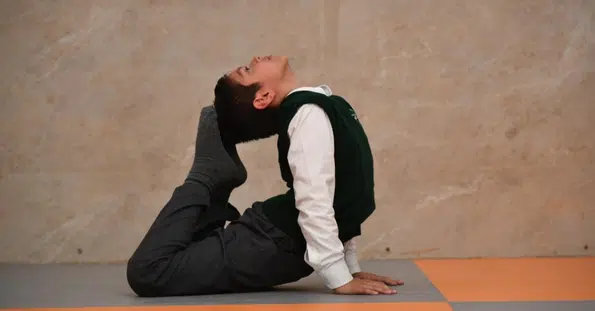15 Benefits of Yoga For Students to Improve Focus
School life can feel like a marathon. There are early mornings, back-to-back classes, piles of homework, and the never-ending cycle of tests and projects. Add social expectations to the mix, and it’s no surprise that many students feel tense, distracted, and even overwhelmed. This is where the benefits of yoga for students come into focus.
Yoga is more than a workout. It steadies the mind when thoughts are racing, builds strength without the strain of heavy exercise, and helps you handle daily challenges with a sense of calm.
From clearer memory during exams to deeper, more restful sleep at night, yoga offers practical support that can fit into even the busiest school schedule.
What Is Yoga?
Yoga is an ancient Indian practice combining breathing, movement, and meditation. It goes beyond stretching. Each posture works with breath control to join mind and body. Regular practice improves flexibility, balance, and strength while calming the nervous system and quieting a racing mind.
Why Yoga Matters for Students?
Students carry a heavy load, including long hours of study, late nights of homework, and the constant pressure to excel in every subject and activity. This stress affects both the body and the mind.
There is great importance of yoga for students in maintaining balance and focus. A few minutes of daily practice can release that built-up tension, steady the breath, and bring clarity to a cluttered mind.
Schools across India and many other countries now include yoga sessions because they have observed its positive impact. Students are calmer, healthier, and more attentive in class.
Whether you are preparing for exams or simply trying to stay balanced through a busy week, yoga provides a natural, reliable way to stay grounded and alert.
Also Read: The Benefits of Mindfulness and Meditation for Teenagers
15 Benefits of Yoga for Students
1. Improves Memory
Yoga stimulates areas of the brain linked to short and long-term memory. This sharper recall helps with everything from learning formulas to remembering key facts during tests. Yoga gives your mind the quiet space it needs to store and retrieve information.
2. Reduces Stress and Anxiety
Yoga breathing and steady poses relax tight muscles and lower stress hormones. Students carrying academic and social pressures notice a calmer mood and fewer anxious thoughts. Even a short daily practice can help you stay composed during exams or busy school days.
3. Boosts Attention Span
A 20-minute session of focused movement and breathing trains your mind to stay present. Over time, this habit reduces distractions during lectures and study hours. Many students find they can listen longer and work more efficiently after consistent practice.
4. Supports Better Mental Health
Yoga’s mix of deep breathing and gentle meditation helps reduce symptoms of anxiety and mild depression. Students often report a brighter outlook and steadier emotions, which makes it easier to handle daily ups and downs without feeling overwhelmed.
5. Builds Physical Strength
Holding yoga poses engages core muscles and uses body weight for resistance. With regular practice, you gain strength in your arms, legs, and back. Stronger muscles improve posture and stamina, allowing you to sit through long classes without fatigue or discomfort.
6. Improves Flexibility and Balance
Stretching through controlled movements loosens tight joints and lengthens muscles. Better balance reduces the risk of injuries during sports and daily activities. For students who spend hours at desks, these stretches counter stiffness and make everyday movement feel easier and more natural.
Also Read: The Importance of Teaching Children Empathy and Compassion
7. Helps Manage Weight
Modern student life often involves excessive screen time and unhealthy eating habits. Yoga keeps the body active, boosts metabolism, and supports healthy habits. For teenagers, this can prevent obesity and encourage a more energetic lifestyle, even if they are not drawn to team sports.
8. Encourages Good Posture
Sitting at a desk or using a laptop for hours can round the shoulders and strain the spine. Yoga strengthens the back and teaches proper alignment, easing aches and helping you maintain an upright posture during study sessions and daily tasks.
9. Promotes Self-Control
Yoga teaches you to guide your breath and movement with care. This self-discipline carries into daily life, reducing impulsive reactions and helping you pause before responding to stress or conflict. Better self-control supports thoughtful choices in school and relationships.
10. Increases Energy Levels
Deep breathing increases oxygen flow throughout the body, enhancing alertness. Students often feel more awake and alert after a morning session, making it easier to start the day with focus. Unlike caffeine, this natural lift keeps energy steady without a crash.
11. Improves Sleep Quality
Yoga relaxes both muscles and mind, preparing the body for restful sleep. A calm evening routine can help you fall asleep faster and wake up refreshed. Consistent practice even raises melatonin levels, which regulate healthy sleep patterns.
12. Reduces Headaches
Hours of reading or screen time can tighten the neck and shoulders, leading to headaches. Gentle stretches and mindful breathing release that tension. Many students notice fewer headaches and clearer concentration after adding regular yoga to their weekly schedule.
13. Strengthens the Immune System
By improving circulation and lowering stress, yoga supports the body’s natural defenses. Better blood flow helps nutrients reach cells efficiently. Students who practice regularly often experience fewer colds and recover more quickly from minor illnesses throughout the school year.
Also Read: Diversity and Inclusion: Celebrating Differences at DPS Gurugram
14. Encourages Self-Care and Confidence
Yoga teaches respect for your body. As strength and flexibility grow, so does self-esteem. Students become more comfortable in their own skin and develop quiet confidence that extends beyond the mat into social settings and academic challenges.
15. Reduces Absenteeism and Conflict
Better health and a balanced temperament lead to fewer sick days and calmer interactions with classmates. Students who practice yoga regularly tend to stay engaged in school life and handle disagreements with patience, which improves both attendance and relationships.
These wide-ranging benefits of yoga for kids show that it is far more than a fitness trend. It supports physical, mental, and emotional growth in a way few other activities can match.
Conclusion
Yoga offers a clear path to stronger health, sharper focus, and a calmer mind. With so many demands on today’s students, it provides relief and lifelong habits for success. Delhi Public School Gurgaon recognizes these benefits of yoga and encourages regular practice so every student can stay healthy, confident, and ready to learn. Adding yoga to your routine builds balance and resilience that will serve you well beyond the classroom.

